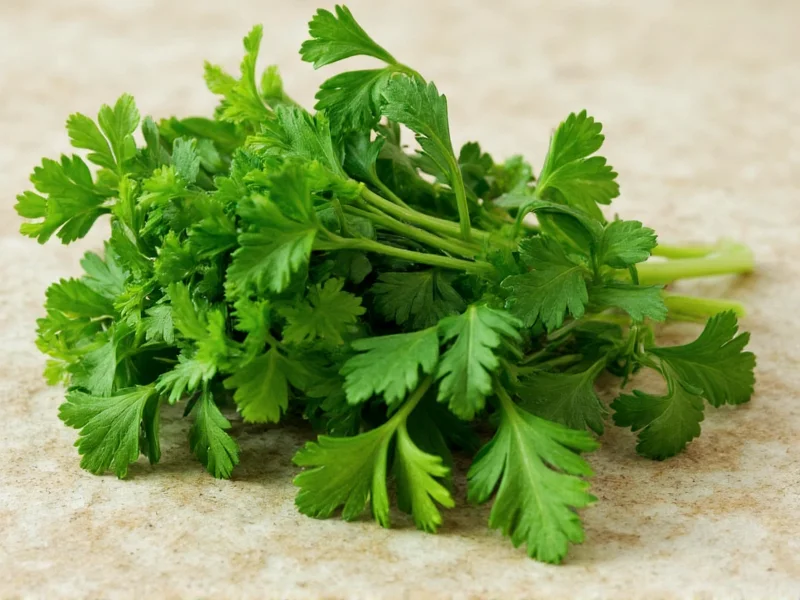Understanding the proper conversion between dried and fresh parsley is essential for achieving balanced flavors in your cooking. While both forms come from the same herb, their flavor intensity differs significantly because drying concentrates the essential oils. Fresh parsley contains about 85-90% water, which evaporates during drying, leaving behind a more potent herb.
Why Dried and Fresh Parsley Aren't Interchangeable
The fundamental difference lies in moisture content and flavor concentration. Fresh parsley has a bright, grassy flavor with subtle peppery notes, while dried parsley develops a more earthy, muted profile. When substituting one for the other without adjusting quantities, you risk creating dishes that are either bland or overwhelmingly herbal.
Precise Dried to Fresh Parsley Conversion Chart
| Dried Parsley | Fresh Parsley Equivalent | Best For |
|---|---|---|
| ¼ teaspoon | ¾ teaspoon chopped | Delicate sauces, egg dishes|
| ½ teaspoon | 1½ teaspoons chopped | Salad dressings, marinades|
| 1 teaspoon | 1 tablespoon chopped | Most cooked dishes, soups|
| 1 tablespoon | 3 tablespoons chopped | Hearty stews, braises|
| 2 tablespoons | 6 tablespoons (¼ cup) chopped | Large batch cooking
When Substitution Works Best (and When It Doesn't)
For most cooked dishes like soups, stews, and sauces, substituting dried for fresh parsley works well when you follow the 1:3 ratio. The extended cooking time allows dried herbs to rehydrate and release their flavors gradually. However, for dishes where parsley serves as a fresh garnish—like tabbouleh, chimichurri, or finished plated dishes—substitution isn't recommended. The texture and bright flavor of fresh parsley are integral to these applications.
Chef's tip: When using dried parsley in place of fresh in cooked dishes, add it earlier in the cooking process (about 20 minutes before completion) to allow proper rehydration and flavor development. Fresh parsley should be added in the last 5-10 minutes or as a garnish to preserve its delicate flavor.
Flavor Profile Differences You Should Know
Fresh parsley offers a vibrant, slightly peppery taste with grassy notes that brighten dishes. Dried parsley develops a more earthy, muted flavor profile with subtle bitterness. The drying process causes some flavor compounds to break down while concentrating others. This is why dried parsley works better in robust dishes like meatloaf or tomato-based sauces, while fresh parsley shines in lighter preparations like salads, fish dishes, and herb sauces.
Storage Tips for Maximum Freshness
Proper storage significantly impacts how long your parsley maintains its flavor. Fresh parsley lasts 1-2 weeks when stored upright in a glass of water (like flowers) covered loosely with a plastic bag in the refrigerator. Dried parsley retains optimal flavor for 6-12 months when stored in an airtight container away from light and heat. After this period, dried herbs lose potency but remain safe to use—simply increase the quantity slightly to compensate for diminished flavor.
Common Substitution Mistakes to Avoid
Many home cooks make these critical errors when substituting dried for fresh parsley:
- Using equal measurements (1:1 ratio) resulting in under-seasoned dishes
- Adding dried parsley at the same stage as fresh, preventing proper rehydration
- Using dried parsley as a garnish, creating unpleasant texture
- Not adjusting for recipe size—larger batches may need slightly less than the standard ratio
Remember that the 1:3 ratio serves as a starting point. Always taste and adjust as you cook, as factors like parsley variety (flat-leaf vs. curly), brand, and storage conditions affect potency. For critical recipes, start with 2½ teaspoons fresh per 1 teaspoon dried, then adjust to taste.
Practical Application in Popular Recipes
Understanding these conversions transforms your cooking:
- Pasta sauces: Use ½ teaspoon dried parsley per serving instead of 1½ teaspoons fresh, added when sautéing aromatics
- Roasted vegetables: Toss with ¼ teaspoon dried parsley per pound before roasting (equivalent to ¾ teaspoon fresh)
- Salmon dishes: Never substitute dried for fresh in finishing sauces—fresh provides essential brightness
- Meatloaf: 1 teaspoon dried parsley works better than 1 tablespoon fresh, as it distributes flavor more evenly throughout











 浙公网安备
33010002000092号
浙公网安备
33010002000092号 浙B2-20120091-4
浙B2-20120091-4